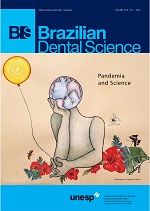Wear Behavior of Monolithic Zirconia against Natural Teeth in Comparison to Two Glass Ceramics with two Surface Finishing Protocols: An In-Vitro Study
DOI:
https://doi.org/10.14295/bds.2020.v23i2.1889Abstract
Objective: To evaluate and compare the wear behavior of three different ceramic systems; monolithic zirconia, lithium di-silicate and nano-fluorapatite glass ceramic with two finishing procedures polishing and glazing, and their effect on the wear of natural tooth antagonists. Material and Methods: Forty two ceramic disc specimens (10mm x3mm) and forty two natural tooth antagonists were used. Samples were divided according to ceramic materials into 3 groups (n = 14). Group I: nano-fluorapatite glass ceramic (FLU) (IPS e.max Ceram), Group II: lithium disilicate (LD) (IPS e.max CAD) and group III: monolithic zirconia (ZIR) (ZirkoZahn Prettau). Each group was further subdivided into two subgroups (n = 7), according to the surface finish: Polishing (P) and glazing (G). Specimens were subjected to a custom designed two-body wear simulator. Quantitative wear assessment was carried out using weight loss measurements. Scanning electron microscope was used for characterization of wear patterns. Kruscal Wallis and Dunn’s tests were used to compare between weight loss of the three ceramic materials. Whitney U test was used to compare the weight loss between the two surface finish protocols. Wilcoxon Signed rank test was used to compare the weight loss between ceramic specimens and antagonist teeth (p ? 0.05). Paired t-test was used to compare weight loss before and after wear test. Results: After wear, LD and FLU had the highest weight loss values compared to ZIR (p < 0.05). For teeth, there was no significant difference between the weight loss values with the three materials (p > 0.05). P and G specimens showed no significant difference in weight loss values. SEM images of the wear patterns verified the previous analysis. Conclusion: ZIR is more wear resistant than LD and FLU. However, the surface treatment had no impact on the wear behavior.
KEYWORDS
Glass-ceramics; Monolithic; Two-body wear simulation; Wear; Zirconia.
Downloads
Downloads
Published
How to Cite
Issue
Section
License
Brazilian Dental Science uses the Creative Commons (CC-BY 4.0) license, thus preserving the integrity of articles in an open access environment. The journal allows the author to retain publishing rights without restrictions.
=================




























